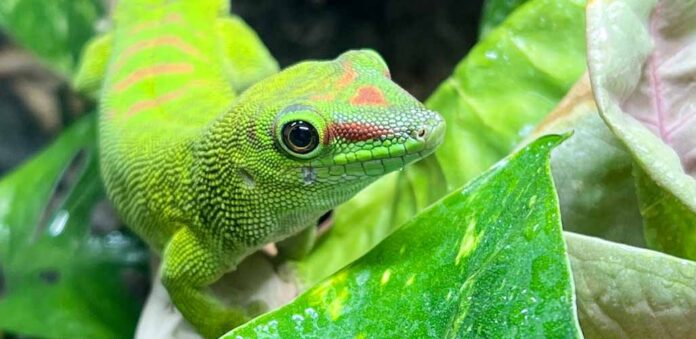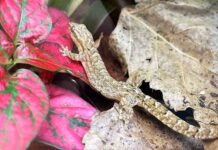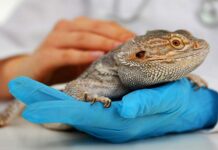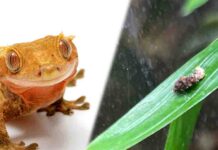The Madagascar Giant Day Geckos, or Phelsuma Grandis, are colorful, shy and super fast. They live high up in the trees, and so do best in crowded naturally planted enclosures. You can feed them entirely on a shop bought rehydrated diet, but they benefit from the enrichment if you offer them live crickets once a week too. And this is the prime opportunity to get to know your timid new friend through tong feeding. My Giant Day Geckos are endlessly entertaining, but not in the way you might expect from a pet.
Contents
- Housing your Giant Day Gecko.
- Heating, lighting and humidity.
- Food and feeding.
- Handling your speedy pet.
Nothing in my exotic collection from Cresties and Dart Frogs, to White’s Tree Frogs and Scorpions, turns heads and gets attention in the way that my Madagascar Giant Day Gecko, Sisu, does. Okay, maybe my Standings Day Geckos do, but they are a very similar species! And the enclosure can be just as amazing and impressive as your new Day Gecko buddy.
The Best Enclosures for Madagascar Giant Day Geckos
Ideally Giant Day Gecko tanks are large and cluttered, with plenty of places to hide. You’ll want plenty of plants and features with a variety of textures and sized spaces.
My Giant Day Gecko tank is 18 x 18 x 25 inches for a single female. She’s very large even for this breed, and in the future I think I will upgrade her to a bigger enclosure, but provided it’s well laid out that’s plenty for now.
I go with bioactive enclosures for all my arboreal reptiles and amphibians, and they look stunning. You’ll start with a drainage layer of clay balls, add a skin of mesh or wool over the top, then put the soil based substrate over that. Plant living plants into the top layer, lay a couple of handfuls of sphagnum moss and generously scatter dried leaves.
Your enclosure needs plenty of climbing opportunities so use a combination of branches and cork bark as well as vertical plants. Make sure there are places to sit a few inches below the heat and light sources.
To Share or Not To Share?
You’ll find mixed opinions on cohabiting reptiles of various kinds, and geckos are no exception. Some of them get along very well and spend their lives happily together, others have huge and sometimes sadly fatal bust-ups after appearing to be content for years. It’s a tricky situation to manage, and in my experience the larger day geckos don’t like friends.
You might find a breeding pair happily cohabit their whole lives, but you’ll still need a tank prepped and ready to go if the relationship breaks down unexpectedly!
Lighting And Heating Your Day Gecko’s Tank
It might surprise you to learn if you are new to reptiles, that lighting is a hotly debated and contentious topic. Some keepers swear blind it just doesn’t matter, and others are almost evangelical in their support of it. I won’t bore you with the ins and outs of the argument here, but instead just give you what I consider to be my educated and informed opinion.
Although some reptiles seem to thrive without separate lighting facilities, the Giant Madagascan Day Gecko appears to benefit from both UVB and an LED based light strip. I have both over my terrarium, two strips sitting next to each other with a brand underneath to allow her to bask there if she choses.
When selecting an LED strip any reptile based design is fine. For the UVB you want one that is aimed at arboreal canopy dwelling species, which is not as strong as some of the other options more focussed on arid species like the bearded dragon or uromastyx.
They also need a heat lamp over a raised basking spot, with a thermostat set to around 88F. Make sure you set the probe where the lizard’s intended basking point will be and fix it in place so it doesn’t get knocked out of position.
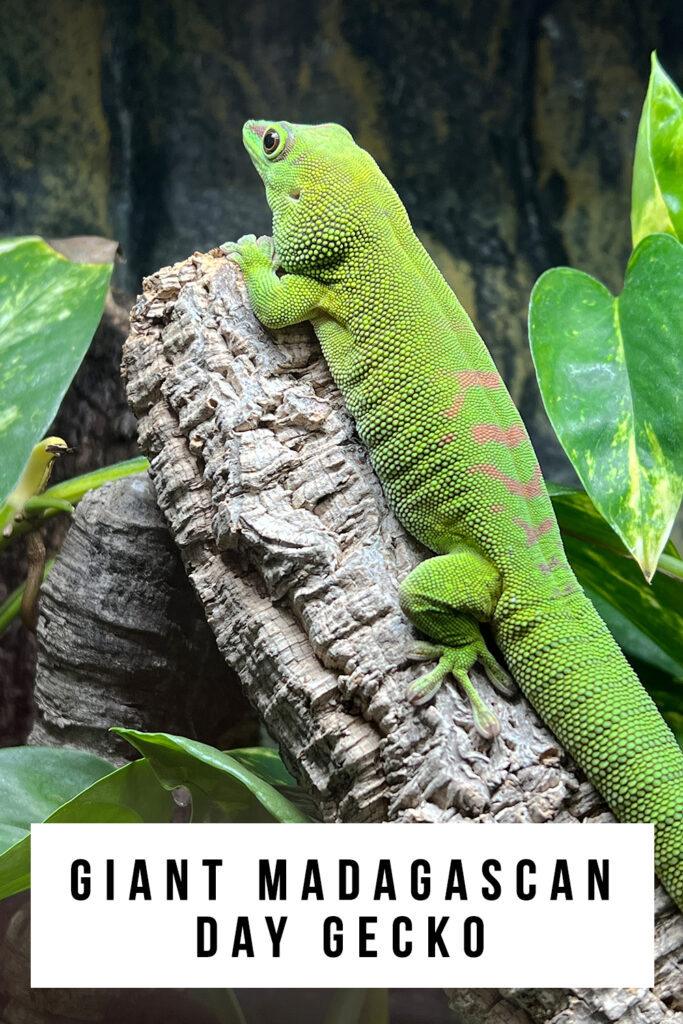
Humidity Levels
Day Geckos like their enclosure to be fairly humid, but the substrate shouldn’t be wet to the touch. Leaves will need spraying regularly as that’s how your little lizard will drink. Delicately lapping droplets of their plants.
Each day you’ll want to spray down your tank with a spray bottle or mister. I just do mine morning and evening, but you can use a humidity detector if you want to be a little more accurate.
Madagascar Giant Day Geckos Shedding
Your Day Gecko should shed easily if the humidity is correct, and the process takes around an hour from start to finish. Although you’ll read in numerous places that giant day geckos shed monthly as adults, this hasn’t been my experience at all. Once they have completely finished growing you might find that they go as long as three or even four months between sheds.
Your gecko is likely to eat her shed, but don’t worry if she doesn’t consume it completely. If your enclosure is bioactive you can leave the shed remains for your isopods to chow down on.
Maintenance and Cleanliness
If you use a bioactive setup then you should be able to stay on top of tank hygiene really easily. I wipe down the glass doors every couple of days when she poops on the window. The bulk of the mess does this graceful slide down the glass and lands in the substrate below for the isopods to munch on, but you will need to use a reptile safe spray and cloth to clear the urate residue from the window. Remember to pop the cloth into a boil wash to prevent the spread of germs. The only other thing I occasionally do is pick a stray poop off a large leaf and drop it down the toilet or into the bottom of the tank if it’s not too large.
Feeding Your Giant Day Gecko
Giant Day Geckos are usually superb eaters. Mine have a dish of repashy or pangea crested gecko diet every other day, and once or twice a week I release two or three crickets into the tank.
Sisu is an amazing hunter and clearly gets a lot of enrichment out of this addition to her diet in terms of mental and physical exercise. She’s incredibly fast, agile and watches her surroundings in a way that looks for all the world like intelligence.
Handling
Giant Madagascan Day Geckos are fast, nervous and nimble. They rarely enjoy handling, though they can become accustomed to you if you tong feed them. Non intrusive interaction like sitting beside the cage is great for helping them to feel more at ease with your presence.
Like all reptiles, letting them go at their own pace is the best way to make them feel comfortable and confident. That said, you are very unlikely to ever have a Day Gecko hand tame. And if they are, their speed and the fact they can drop their skin as well as their tail means it’s not something I’d recommend.
Visibility
So this isn’t the most handleable species, but do you know what, that’s not really what they are about. Although all geckos are all amazing creatures, the real downside I have found with several species like the Mourning Gecko or Crested Gecko is their inclination to hide during the day. If you are a real night owl this isn’t such an issue, but my reptile room is also my office and I love being able to see my animals awake when I am.
Although Sisu has a huge number of places she could hunker down, she chooses to spend almost the entire day out in the open. Her favorite spots to hang out are on the ledge directly under the heat bulb, or upside down on the glass door right next to me, watching as I type. Which also as it happens is her top place to poop, so thanks for that Sisu.
Still, my Giant Day Geckos are beautiful, decorative and a complete honor to share my home with.

